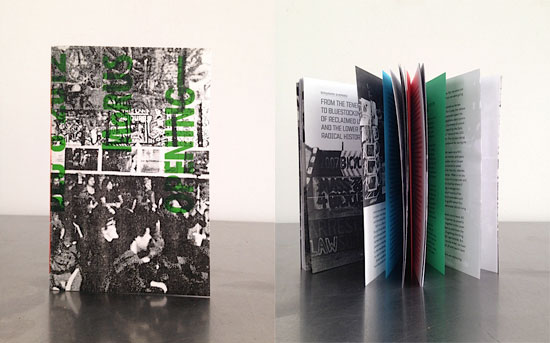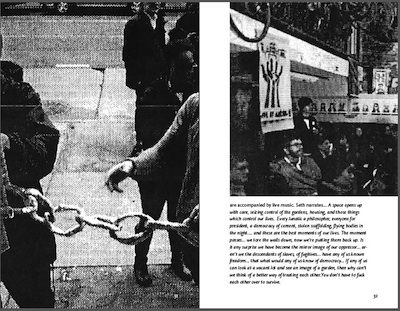A Museum of Reclaimed Urban Space Opening—
a moment’s Catalog; December 8, 2012
64 pages-
letterpress cover, hand-sewn binding,
photocopy interior.
Limited Print-run of 150 books.
Ben Shepard- editor
Emily Larned (red charming) - designer
A catalog for the Museum of Reclaimed Urban Space - museum
To be shipped in early December.

On October 29th, 2012, C-Squat on Avenue C in New York's Lower East Side was flooded by the wilds of
Hurricane Sandy. The Museum of Reclaimed Space (MORUS), located in its basement, was scheduled to have its opening party that night. The next morning the MORUS community, instead, was bucketing water and salvaging displays. They also hosted a pedal-power bike generator to recharge cell-phones and became a node for dumpstered food distribution.
Ben Shepard, with an assist by Marc Herbst, has put together an ode, a short book about activist New York under Hurricane Sandy and a re-telling of the eventual opening of MORUS on December 8 2012.
Contributions:
by Alan W. Moore, Stephen Duncombe, Maggie Wrigley and Frank Morales.
Art by Fly, Mac McGill and others.
This book honors this Lower East Side Museum's DIY spirit through the hand-made (letter-press cover and hand-stitched binding), economy of resources (low price, packed with images) and zine-iness (interior is photocopied, yo).
Oh, its also really good looking.

pages 31, 32

pages 18 and 19
Excerpts:
"The founding of the MoRUS signals a historicizing self-reflective bent that has taken hold of some among this tribe. The Squatter Rights and Times Up bicycle activist archives that were put together for the Tamiment Library several years ago were an early sign of this, preserving important political and subcultural movement documents for study. But the MoRUS is much more ambitious. It is also held together by young people, volunteers who sit the desk and run the errands. So there must be something in it for them, some information and experience they need to negotiate their lives in these times."
- Alan W. Moore
"...This is not our problem. In the New World we look backwards and see nothing. Ours is a world populated by people fleeing from or pushed out of history. Immigrants running away from class oppression, political persecution, or religious intolerance. Slaves ripped out of their history and forbidden to remember. Native peoples whose history was systematically exterminated. Those of us who came to the Lower East Side are no different; not only the waves of immigrants -- the Dutch, English, German, Jewish, Ukrainian, Puerto Rican, Dominican, and Chinese -- but also the American-born migrants from towns and cities and suburbs across the United States, desperately leaving the histories of bigotry, homophobia and all sorts of small-thinking that made our lives wherever we chanced to be born unbearable. We came to the Lower East Side to look forwards, to forget our past and build a present more to our liking."
- Stephen Duncombe
“One particular Saturday, December 8th 2012 to be exact, we continued such a conversation at the opening party of the Museum of Reclaimed Urban Space.
Much of the activist perspective on this history is being whitewashed away,” says Bill ‘Times Up!’, echoing Sarah Schulman's point from the Gentrification of the Mind, that positive social changes does not happen because politicians are nice; they happens because people have fought for them using direct action. “AIDS drugs were not released because the US government became nice, AIDS activists forced them to do the right thing. Gardens are not preserved because the city likes them. They survive because people fought for them.”
Much of the genesis for MoRUS was born of conversations like this one. Knowing this history, Bill suggested we open a museum to highlight the neighborhood’s real activist history. This alternate history is the subject of the Museum of Reclaimed Urban Space."
- Ben Shepard